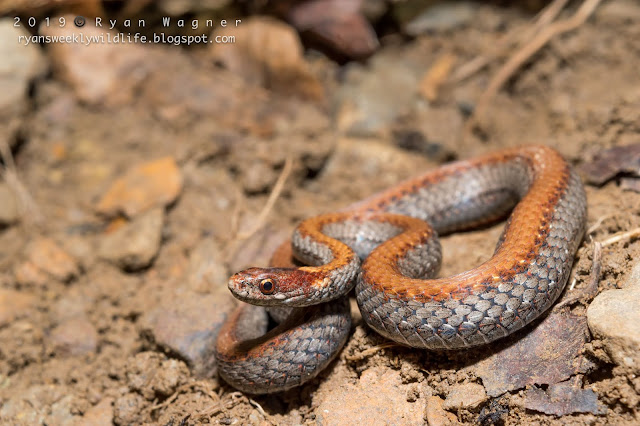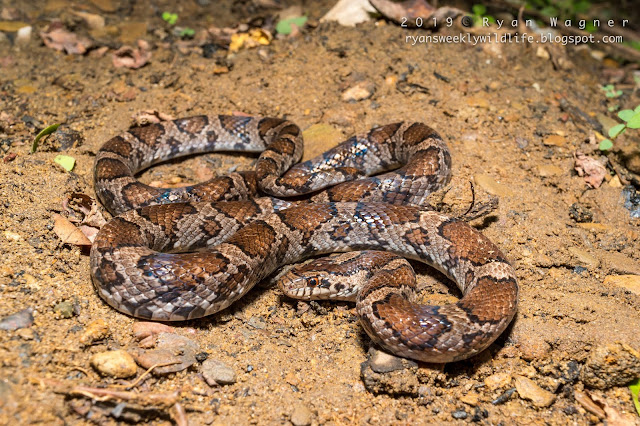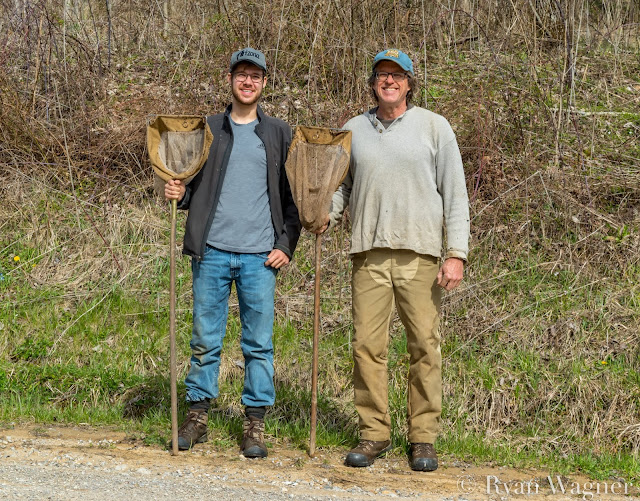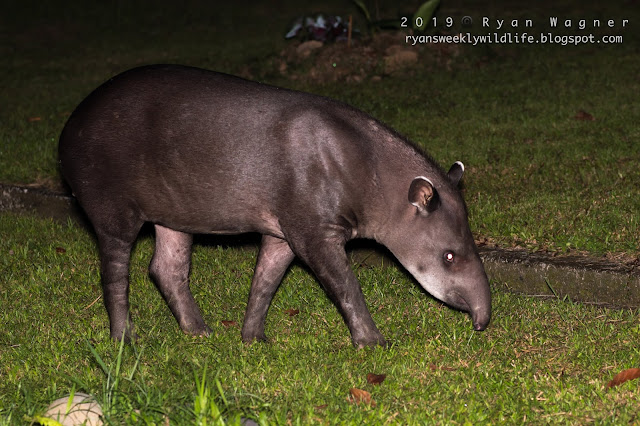“Also, there were many objects to overturn, and there was always the chance of finding something unusual beneath any log or rock. Springs and both clear and muddy streams abounded. In short, there was a great variety of habitats to be explored. The net result was that we probably spent more man hours in the hill country than in any other part of the state. Southeastern Ohio was unquestionably our favorite collecting area.”
—Roger Conant
Herpetology in Ohio—50 Years Ago
 |
| Northern Red-bellied Snake. |
Gravel crunched under our tires as we pulled off Route 50 onto the first backroad of the day. The morning sun was already beginning to bake away any evidence of last night’s rain, but by midday, our sweat-stained shirts and hair would look as if a storm had caught us by surprise. My backpack held two full water bottles, a tablet of dissolved electrolytes in each. A third and a fourth were stashed below the rear seat next to Carl’s water-filled orange juice containers. Neither of us wanted to tempt fate by running out of water in the heat of Ohio's Hill Country.
As we pulled to a stop along the roadside, the fluttering hum of cicadas died down and the air hung still for a moment as if the forest was waiting to inhale. I grabbed my snake stick from the bed of the truck as Carl slipped his backpack over his head. We both knew the drill. The hillsides all around us held promise of snakes, lizards, and turtles hidden below cover.
 |
| Eastern Black Kingsnake. |
During each of our treks into Ohio’s backwoods, I can’t help but feel we are a small instance of history repeating itself. Just shy of a century ago, Roger Conant might have hiked these very same hillsides and ravines. In the 1930s, Conant was the first to attempt an exhaustive survey of Ohio’s reptile diversity (an undertaking sorely in need of updating since the previous survey by Kirtland in 1838). During his six years as Curator of Reptiles at the Toledo Zoo, he would eventually make it to 87 of Ohio’s 88 counties, drive some 41,000 miles, collect countless voucher specimens, and publish his collective work in The Reptiles of Ohio in 1938.
Like us, weekends were Conant’s designated field days. He would travel from his home base in Toledo, accompanied by a small and variable band of zoo colleagues, local naturalists, and a few wide-eyed teenagers, all eager to indulge their persistent childhood urges to catch the scaly and slimy. The crew would pack snake bags and collecting jars into Roger’s 1931 Chevy and set out for the unknown. Their findings were quintessential, helping to verify species records and contributing to the state’s first range maps.
 |
| Eastern Smooth Earthsnake. |
Conant’s work wasn't limited to Ohio alone. Take down your copy of A Field Guide to Reptiles and Amphibians of Eastern and Central North America and you’ll find a conspicuous authorship. For most of us fascinated with reptiles and amphibians (Carl and myself included), this field guide was our ticket into the world of herpetology. Anyone who herps Ohio today (or anywhere in North America) is indebted to the work of Conant and his colleagues.
For over 15 years, Carl Brune has spent his free weekends and rainy evenings ‘filling in Conant’s gaps.’ Originally from California, Carl moved to Ohio to teach physics at Ohio University. He has helped to expand the known ranges of species from copperheads to streamside salamanders, and has even authored two chapters in the Amphibians of Ohio Textbook.
 |
| Northern Copperhead. |
I began herping with him in late August 2017. Growing up in a suburb of Cleveland, reptile diversity was somewhat lacking. For as long as I can remember, I’ve dreamed of seeing the creatures hidden among the rolling hills of Ohio’s southern counties. In 2016, I moved to Athens to study Wildlife Biology and Conservation. By luck or fate, I found myself in the middle of one of Ohio’s most herpetologically diverse regions.
 |
| A map of the physiogeographic regions of Ohio from Conant's The Reptiles of Ohio. |
It is no secret that Roger Conant preferred the Hill Country over any of Ohio’s other physiogeographic regions. Eleven of the thirty reptile species he documented there were found nowhere else in the state. The Hill Country encompasses the southeastern third of Ohio and sits on the Unglaciated Allegheny Plateau at the base of the Appalachian Mountains. Except for the blue grass region, the Hill Country is the only part of Ohio that was free of ice during the Pleistocene. When the glaciers receded at the end of the last ice age, their melt waters carved out the labyrinth of ravines and hilltops that define the Hill Country of today.
 |
| Black Racer. |
Before the arrival of Europeans, 95% of Ohio was covered by huge stands of old-growth forest. Oaks and hickories cloaked the rolling hills and provided habitat for wolves, bison, elk, black bear, and even wolverine. By the beginning of the 1900s, the state’s megafauna would be gone, and the forest would be reduced to 10% of its former grandeur. The trees were cleared for timber and to allow access to the exposed layers of coal, iron, and oil. Once these natural resources were fully exploited, industry moved on, and the forests were allowed to regrow. Remnants of old coal towns and iron districts still stand in isolated pockets of the backwoods, totems to this past age.
 |
| Northern Ring-necked Snake. |
By the 1930s, second-growth had returned to much of southeastern Ohio. Conant described the state of the forest in his autobiography, “The charm of the hill country lay largely in the fact it was mostly wild in those days. Agriculture was confined to some of the valleys, and second growth had re-clothed the hillsides and many other areas to the point where the forest had more or less returned to its original climax stage.” As much as 70% of the Unglaciated Allegheny Plateau is now forested. Glacial melt waters washed away most of the area’s rich soil, sparing the land from agriculture. Had the soil been more profitable, the Hill Country would likely be a very different place today.
Despite the disappearance of many of Ohio’s native fauna during this era of rapid and intense deforestation, there have been no documented extinctions for any of Ohio’s 47 species of reptile or 40 species of amphibian. Just how and where these fragile creatures survived is something of a mystery. Logging took place over many decades, and it is possible species found refuge in small, remaining tracts of habitat, recolonizing the surrounding land once the forest had regrown. Considering the scale of habitat loss that swept through Ohio in the 1800s, it is remarkable any native herpetofauna survived at all.
 |
| Black Ratsnake. |
One thing is clear, however, Ohio’s reptiles and amphibians are no strangers to adverse environmental conditions. A year (or even a day) in Ohio can fluctuate wildly in temperature and weather conditions. Winter lasts for nearly half the year, forcing ectothermic species to remain inactive for months on end. Summer is prime herping season, but with midday temperatures easily reaching 90 degrees Fahrenheit in southern Ohio, most species are forced to seek shelter to avoid overheating or desiccating.
Logs and rocks provide cool, moist places for snakes to hide during the heat of the day. Nature, however, can be supplemented with a little human ingenuity. In Conant’s time, logging operations left behind huge saw dust piles strewn along the steep slopes. When covered with pieces of hacked-off bark, these damp, sturdy piles provided the perfect escape from the elements. Conant recounts one exceptionally good find, “a large slab-covered pile in Hocking County yielded a fence lizard, three young broad head skinks, a northern water snake, eleven hatchling black rat snakes, and two juvenile copperheads.” As mill practices shifted, Conant’s fruitful saw dust piles became a thing of the past.
 |
Eastern Milksnake.
|
Today, man-made cover is still important for finding snakes. Plywood boards and tins scattered throughout the roadsides and hilltops of southern Ohio are easily flipped and are a proven way to find scads of snakes in an otherwise desolate landscape. Reptiles aren't picky; old pool liners, ratty carpets, deck chairs, smashed televisions, and gas tanks might be an eye sore for most hikers, but for folks like us, they’re a treasure trove. A good trash pile always gets my blood pumping in anticipation of what might be lurking below.
During the course of our search, Carl and I might flip upwards of 100 pieces of cover and hike ten miles through the ravines and hilltops, all to find a handful of serpents. Somedays, the snakes are plentiful, others require hours of work to find the most common of species. There is really no telling where or when a species might turn up; it's often a matter of being in the right place at the right time.
 |
| Eastern Wormsnake. |
Carl and I have been lucky enough to find more snakes in Ohio than most people will see in their entire lives. Even where snake populations appear stable, however, the impacts of humans are plainly visible. Whether it be road mortality, habitat loss, or direct persecution, "snakes engender mighty little sympathy from the general public," a statement that still rings true today.
Conant was well aware that with each decade, more species were pushed closer toward extirpation. Fifty years after his surveys, Conant lamented that, “many places that once supported thriving colonies of various species have vanished.” Rattlesnakes, spotted turtles, Kirtland’s snakes—species Conant would have commonly encountered in his day—have all but disappeared from most of the state.
 |
| Timber Rattlesnake. |
Conant laid the ground work for our modern generation of herpetologists. It is now up to us to protect the species and populations that remain. Efforts to mitigate the damage we have done to our natural environment can often seem confusing and convoluted, but I have found there is something very down to earth about the study of reptiles and amphibians. Even someone unaccustomed to the complex and long-winded jargon of scientific literature might be able to detect a hint of the adventure and mystery only thinly veiled behind tables of snout-vent lengths and scale counts.
Hobby, obsession, the ‘weird’ cousin of birding, call it what you will, but herping has captivated my life ever since I first opened Roger Conant's field guide. In a few months time, the snakes, lizards, and turtles will begin to emerge from their frozen retreats. Carl and I will soon be back among the rolling hills of Southern Ohio, flipping logs, boards, and carpets for the secrets hidden beneath. Only time will tell what we find.
 |
| Carl and myself after a day of dip netting for salamanders in 2018. |
Ryan Wagner is a student studying Wildlife Biology and Conservation at Ohio University. He is an avid herper, birder, nature blogger, and wildlife photographer. You can read more of his articles at ryansweeklywildlife.blogspot.com or follow him on twitter @weeklywildlife. You can read the guest post version of this blog at Jim McCormac's Birds and Biodiversity Blog.




















